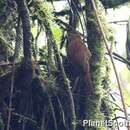en
names in breadcrumbs


The ruddy treerunner (Margarornis rubiginosus), is a passerine bird which is endemic to the highlands of Costa Rica and western Panama.
This treerunner is found in hills and mountains from 1200 m up to the timberline, in forests and adjacent edges and clearings. It builds a large enclosed oval nest 25 m high in the crown of a tree on the underside of a thick branch. The nest is camouflaged with mosses and epiphytes and has a downward pointing entrance tunnel at its base[1]. The eggs are undescribed, but members of this family typically lay two white eggs.
The adult ruddy treerunner is 16 cm long, weighs 18 g and looks like a small, short-billed woodcreeper, but has soft, rather than rigid, tail spines. It has bright rufous upperparts and a white supercilium. It has a white throat and otherwise tawny underparts. Young birds are almost identical to the adults. The call is a sharp tsit, and the song is a twittering trill.
The ruddy treerunner forages for large insects, spiders and their eggs and larvae in mosses, plant debris, bromeliads and other epiphytes. It creeps along branches and up stems - but uses its tail for support less than a woodcreeper does. It is seen alone, in pairs, or as part of a mixed-species feeding flock.
The ruddy treerunner (Margarornis rubiginosus), is a passerine bird which is endemic to the highlands of Costa Rica and western Panama.
This treerunner is found in hills and mountains from 1200 m up to the timberline, in forests and adjacent edges and clearings. It builds a large enclosed oval nest 25 m high in the crown of a tree on the underside of a thick branch. The nest is camouflaged with mosses and epiphytes and has a downward pointing entrance tunnel at its base[1]. The eggs are undescribed, but members of this family typically lay two white eggs.
The adult ruddy treerunner is 16 cm long, weighs 18 g and looks like a small, short-billed woodcreeper, but has soft, rather than rigid, tail spines. It has bright rufous upperparts and a white supercilium. It has a white throat and otherwise tawny underparts. Young birds are almost identical to the adults. The call is a sharp tsit, and the song is a twittering trill.
The ruddy treerunner forages for large insects, spiders and their eggs and larvae in mosses, plant debris, bromeliads and other epiphytes. It creeps along branches and up stems - but uses its tail for support less than a woodcreeper does. It is seen alone, in pairs, or as part of a mixed-species feeding flock.